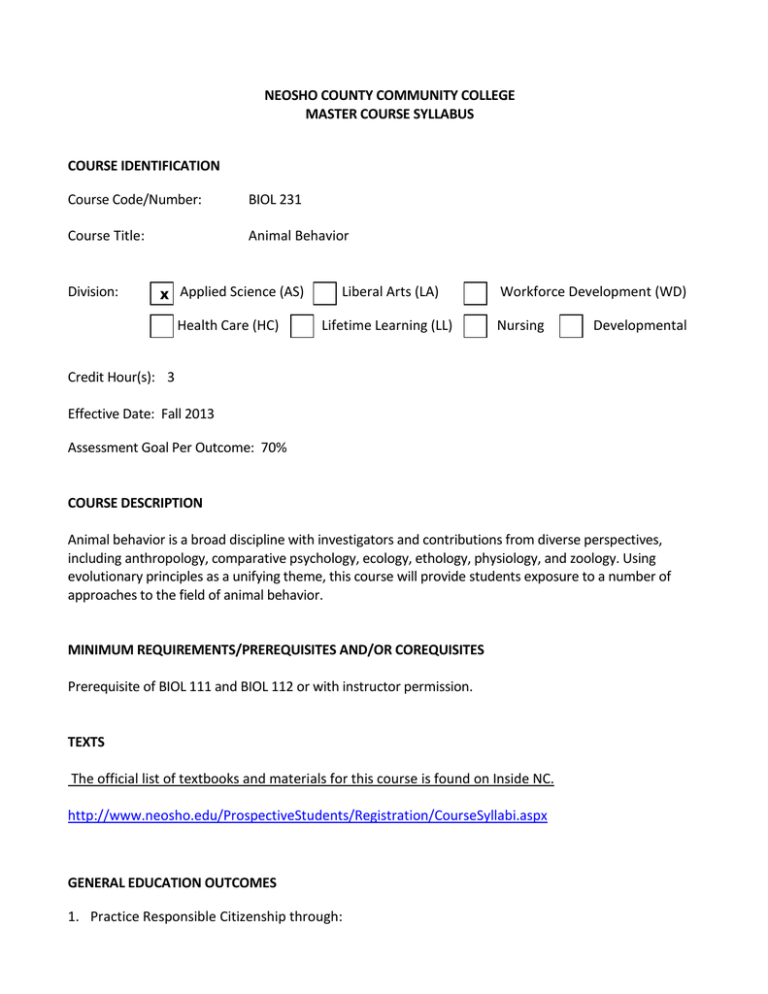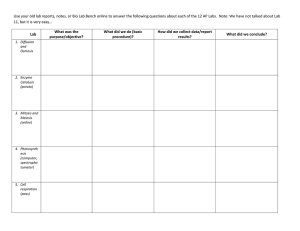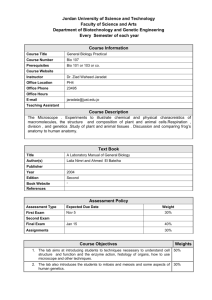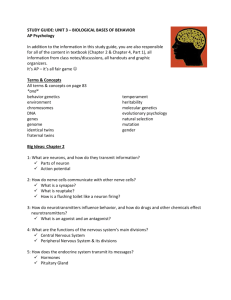NEOSHO COUNTY COMMUNITY COLLEGE MASTER COURSE SYLLABUS COURSE IDENTIFICATION
advertisement

NEOSHO COUNTY COMMUNITY COLLEGE MASTER COURSE SYLLABUS COURSE IDENTIFICATION Course Code/Number: BIOL 231 Course Title: Animal Behavior Division: X Applied Science (AS) Health Care (HC) x Liberal Arts (LA) Lifetime Learning (LL) x x Credit Hour(s): x3 Effective Date: Fall 2013 Assessment Goal Per Outcome: 70% Workforce Development (WD) x x x x Nursing Developmental x x x x x x x COURSE DESCRIPTION Animal behavior is a broad discipline with investigators and contributions from diverse perspectives, including anthropology, comparative psychology, ecology, ethology, physiology, and zoology. Using evolutionary principles as a unifying theme, this course will provide students exposure to a number of approaches to the field of animal behavior. MINIMUM REQUIREMENTS/PREREQUISITES AND/OR COREQUISITES Prerequisite of BIOL 111 and BIOL 112 or with instructor permission. TEXTS The official list of textbooks and materials for this course is found on Inside NC. http://www.neosho.edu/ProspectiveStudents/Registration/CourseSyllabi.aspx GENERAL EDUCATION OUTCOMES 1. Practice Responsible Citizenship through: identifying rights and responsibilities of citizenship, identifying how human values and perceptions affect and are affected by social diversity, identifying and interpreting artistic expression. 2. Live a healthy lifestyle (physical, intellectual, social) through: listing factors associated with a healthy lifestyle and lifetime fitness, identifying the importance of lifetime learning, demonstrating self-discipline, respect for others, and the ability to work collaboratively as a team. 3. Communicate effectively through: developing effective written communication skills, developing effective oral communication and listening skills. 4. Think analytically through: utilizing quantitative information in problem solving, utilizing the principles of systematic inquiry, utilizing various information resources including technology for research and data collection. COURSE OUTCOMES/COMPETENCIES (as Required) Upon successful completion of Animal Behavior, the student should be able to: 1. Describe and Demonstrate an Understanding of the General Study of Animal Behavior a. Identify and Describe Reasons For Studying Animal Behavior b. Explain a Case Study: The Monarch Butterfly Behavioral Genetics and Evolution Mechanisms of Behavior Food and Shelter c. Identify and Describe Social Organizations and Mating Systems d. Describe and Differentiate Proximate Versus Ultimate Causation 2. Demonstrate an Understanding of the History of the Study of Animal Behavior a. Explain Interest in Animal Behavior Early Humans Classical World b. Describe Foundations of Animal Behavior Theory of Evolution by Natural Selection Comparative Method c. Identify and Describe Experimental Approaches Studies of Mechanisms Studies of Function and Evolution Behavioral Ecology and Sociobiology 3. Identify, Describe, and Demonstrate an Understanding of Approaches and Methods a. Identify and Describe Approaches in Animal Behavior Ethology Comparative Psychology Behavioral Ecology and Sociobiology b. Identify and Describe Design Features in Animal Behavior Studies Definitions and Records Design of the Experiment Variation and Variance Capturing, Marking, and Tracking Animals and Animal Signs Field Methods for Data Collection Method Pitfalls c. Describe Applied Animal Behavior d. Identify and Describe the Use of Animals in Research 4. Identify, Describe, and Demonstrate an Understanding of Behavior Genes and Evolution a. Describe Basic Principles of Genetics Chromosomes, Genes, and Alleles Mutation as a Source of Genetic Variation Sexual Reproduction and Genetic Variation b. Describe Evolution Darwin and the Theory of Natural Selection Other Causes of Evolution The Hardy-Weinberg Equilibrium Fitness and Adaptation Units of Selection c. Recognize Limitations and Cautions About Adaptive Explanations 5. Identify, Describe, and Demonstrate an Understanding of Behavioral Genetics a. Identify Questions in Behavioral Genetics b. Describe Single Gene Effects Mendelian Crosses Mutations Knockout Genes Mosaics c. Describe Multigenic Effects: Simpler Methods Cross-Fostering Experiments Twin and Adoption Studies Inbred Lines d. Describe Multigenic Effects: Quantitative Genetics Quantitative Traits and the Sources of Behavioral Variation Heritability e. Identify and Describe Quantitative Genetics Techniques Artificial Selection Parent-Offspring Regression Caveats about Heritability Estimates Quantitative Trait Locus Analysis 6. Identify, Describe, and Demonstrate an Understanding of Evolution of Behavior Patterns a. Describe Microevolutionary Changes in Behavior Domestication and Behavioral Change Natural Selection in the Field b. Describe Macroevolutionary Changes in Behavior Behavior and the Fossil Record Studies of Adaptive Radiation Phylogeny and the Comparative Approach Behavior and Speciation 7. Identify, Describe, and Demonstrate an Understanding of The Nervous System a. Identify and Describe a Nerve Cell The Neuron at Rest Action Potentials Synapses b. Describe Phylogenetic Variation Across Nervous Systems Simple Systems Radially Symmetrical Nervous Systems Bilaterally Symmetrical Nervous Systems The Vertebrate Nervous System c. Identify and Describe Sensory Receptors Chemoreceptors Mechanoreceptors Electroreceptors Thermoreceptors Photoreceptors Processing and Filtering Sensory Information c. Describe the Control of Movement d. Identify and Describe Methods of Investigating the Nervous System Recording Neural Activity, Neural Stimulation, and Self-Stimulation Transection, Lesions, and Transplantations Functional Neuroanatomy and Imaging Psychopharmacology and Cannulation Metabolic Activity of Neurons Potential Problems e. Discuss Examples of Neurobiology and Behavior The Mechanics of Feeding Repetitive Movement Escaping Danger Detecting Prey Communication Learning and Memory 8. Demonstrate an Understanding of Hormones and Behavior, and Immunology and Behavior a. Describe General Features of Endocrine Systems b. Identify and Describe Invertebrate Endocrine Systems c. Identify and Describe Vertebrate Endocrine Systems d. Identify and Describe Experimental Methods e. Identify and Describe Organizational Effects Sexual and Aggressive Behavior Additional Examples of Organizational Effects Thyroid and Adrenal Glands Invertebrates f. Identify and Describe Activational Effects Aggression and Sexual Behavior Patterns Hormones and Cognition Secondary Sex Characteristics Eclosion Life Stages Molting Color Change g. Identify and Describe Behavioral-Endocrine Effects h. Identify and Describe Endocrine-Environment-Behavior Interactions Reproductive Sequence in Ring Doves Parturition and Maternal Behavior in Rats Reproduction in Lizards Reproduction in House Sparrows i. Identify and Describe Hormone-Brain Relationships j. Identify and Describe Hormones in Relation to Ecology k. Identify and Describe Immune System and Behavior Immune System Implications for Behavior 9. Identify, Describe, and Demonstrate an Understanding of Biological Rhythms a. Describe Biological Rhythms with Respect to BehaviorTypes of Rhythms Endogenous Pacemaker Zeitgebers Models Location and Physiology of the Pacemaker b. Discuss the Significance of Biological Timekeeping Ecological Adaptations Diurnality Applied Aspects of Circadian Clocks Hibernation Migration Combined Clocks 10. Identify, Describe, and Demonstrate an Understanding of Development of Behavior a. Describe and Differentiate Nature, Nurture, and Niche Genetic Influences Environmental Influences Epigenesis and Ontogenetic Niche b. Describe Embryology of Behavior Nervous System Development Sensory and Motor Stimulation Maternal Experiences Affect Offspring Behavior c. Discuss Early Postnatal Events Imprinting Development of Feeding and Food Preferences d. Describe Juvenile Events: Birds and Mammals Deprivation/Enrichment Experiments Bird Song Puberty in Female House Mice e. Describe Juvenile Events: Insects and Fish Insects Fish f. Identify and Discuss Play Behavior Functions Canids Keas Human Children g. Discuss Development into Adult Life 11. Identify, Describe, and Demonstrate an Understanding of Learning a. Identify and Describe Forms of Learning Habituation Classical Conditioning Sensitization Operant Conditioning Classical and Operant Conditioning Compared Other Aspects of Learning b. Discuss Invertebrate Learning Protozoa and Cnidaria Platyhelminthes and Annelida Mollusca Anthropoda c. Discuss Vertebrate Learning Rats and Monkeys Vertebrae Intelligence d. Discuss Comparison Across Phyla e. Discuss Preparedness and Constraints on Learning Biological Constraints---Preparedness Methodological Constraints f. Describe Learning as Adaptive Behavior Feeding Predator-Prey Relations Reproduction and Parenting g. Describe Animal Cognition Pigeons Chimpanzees Parrots Vervet Monkeys Corvids Song Learning Self-Recognition 12. Identify, Describe, and Demonstrate an Understanding of Communication a. Describe Communication b. Describe Signals of Information Discrete and Grades Signals Distance and Duration Composite Signals, Syntax, and Context Metacommunication c. Identify and Describe Functions of Communication Group Spacing and Coordination Recognition Reproduction Agonism and Social Status Alarm Finding Food Giving and Soliciting Care Soliciting Play Synchronization of Hatching d. Identify and Describe Channels of Communication Odor Sound Low-Frequency Sound and Seismic Vibrations Touch Electric Field Vision e. Discuss Evolution of Displays f. Describe Complex Communication Food Location in Honeybees Language Acquisition 13. Describe, and Demonstrate an Understanding of Migration, Orientation, and Navigation a. Describe Migration Birds Mammals Other Vertebrates Invertebrates b. Describe Orientation c. Describe Navigation Path Integration Piloting Compass Orientation Olfactory Cues Magnetic Field Meteorological Cues Neural Mechanisms 14. Identify, Describe, and Demonstrate an Understanding of Habitat Selection a. Identify Presence or Absence of Species: Factors Restricting Habitat Use Dispersal Ability Behavior Interactions with Other Organisms Physical and Chemical Factors b. Discuss Dispersal from the Place of Birth Inbreeding Avoidance Hypothesis Intraspecific Competition Hypothesis Examples of Dispersal Inbreeding Versus Outbreeding c. Discuss Habitat Choice and Reproductive Success d. Identify Proximate Factors: Environmental Cues e. Describe Determinants of Habitat Preference Heredity Learning and Early Experience Tradition f. Discuss Theory of Habitat Selection 15. Identify, Describe, and Demonstrate an Understanding of Foraging Behavior a. Discuss Optimality Theory b. Discuss Foraging Models Choice of Food Items: The Prey Model How Long to Stay in a Patch Central-Place Foraging Risk-Sensitive Foraging Effects of Competitors on Foraging Behavior Effects of Predators on Foraging Behavior State-Sensitive Models of Foraging c. Identify Techniques for Acquiring Food Modifying Food Supply Trap Building Electromagnetic Fields Aggressive Mimicry Tools d. Discuss Foraging and Social Behavior Sharing Information Cooperative Hunting e. Describe Defense Against Predators Individual Strategies Social Strategies 16. Identify, Describe, and Demonstrate an Understanding of Conflict a. Describe Aggression, Agonistic Behavior, and Competition Definitions Competition for Resources Exploitation and the Ideal Free Distribution Interference Competition and Resources Defense b. Describe Conflict about Physical Space Territory d. Identify and Describe Dominance Dominance Hierarchies Dominance Hierarchy in the Rhesus Monkey Cost and Benefits of Dominance e. Describe Infanticide and Siblicide f. Discuss Internal Factors in Aggression Hormones Neural Mechanisms Genetics g. Discuss External Factors in Aggression Learning and Experience Pain and Frustration Social Factors Sex and Hunger h. Discuss Evolution of Restraint and Appeasement Game Theory Models i. Describe Relevance of Evolution of Restraint and Appeasement for Humans Social Control and Social Disorganization 17. Describe and Demonstrate an Understanding of Sexual Reproduction and Parental Care a. Discuss Cost and Benefits of Sex Cost of Sex Benefits of Sex b. Describe Anisogamy and the Bateman Gradient c. Discuss Sex Determination and the Sex Ratio d. Describe Sexual Selection Intersexual Selection Intrasexual Selection 18. Describe and Demonstrate an Understanding of Mating Systems and Parental Care a. Identify and Describe Mating Systems Monogamy Polygyny Polyandry Ecology and Mating Systems Alternative Reproductive Tactics b. Describe Parental Care Ecological Factors Which Sex Should Invest? Examples of Parental Investment c. Discuss Parent-Offspring Recognition d. Discuss Parent-Offspring Conflict e. Describe Sibling Rivalry 19. Identify, Describe, and Demonstrate an Understanding of Social Behavior a. Discuss Changing Perspectives in the Study of Social Behavior Early Studies Later Studies b. Discuss Advantages and Disadvantages of Living in Groups Benefits of Group Living Cost of Group Living c. Describe the Evolution of Cooperation and Altruism Kin Selection Reciprocity Mutualism and the Appearance of Altruism d. Identify Examples of Social Systems A Taxonomic Overview Communal Breeding and Helpers at the Nest Eusociality Humans MINIMUM COURSE CONTENT The following topics must be included in this course. Additional topics may also be included. 1. Introduction to Animal Behavior A. Why We Study Animal Behavior B. The Monarch Butterfly: A Case Study C. Proximate Versus Ultimate Causation 2. History of the Study of Animal Behavior A. Interest in Animal Behavior B. Foundations of Animal Behavior C. Experimental Approaches 3. Approaches and Methods A. Approaches B. Design Features in Animal Behavior Studies C. Applied Animal Behavior D. Using Animals in Research 4. Genes and Evolution A. Basic Principles of Genetics B. An Introduction to Evolution C. Cautions about Adaptive Explanations 5. Behavioral Genetics A. Questions in Behavioral Genetics B. Studying Single Gene Effects C. Studying Multigenic Effects: Simpler Methods D. Studying Multigenic Effects: Quantitative Genetics E. Quantitative Genetics Techniques F. Parent-Offspring Regression 6. Evolution of Behavior Patterns A. Microevolutionary Changes in Behavior B. Macroevolutionary Changes in Behavior 7. The Nervous System A. The Nerve Cell B. Phylogenetic Variation across Nervous Systems C. Sensory Receptors D. The Control of Movement E. Methods of Investigating the Nervous System F. Examples of Neurobiology and Behavior 8. Hormones and Behavior, and Immunology and Behavior A. General Features of Endocrine Systems B. Invertebrate Endocrine Systems C. Vertebrate Endocrine Systems D. Experimental Methods E. Organizational Effects F. Activational Effects G. Behavioral-Endocrine Effects H. Endocrine-Environment-Behavior Interactions I. Hormone-Brain Relationships J. Hormones and Ecology K. Immune System and Behavior 9. Biological Rhythms A. Biological Rhythms with Respect to Behavior B. Significance of Biological Timekeeping 10. Development of Behavior A. Nature - Nurture - Niche B. Embryology of Behavior C. Early Postnatal Events D. Juvenile Events: Birds and Mammals E. Juvenile Events: Fish and Insects F. Play Behavior G. Development into Adult Life 11. Learning A. Forms of Learning B. Invertebrate Learning C. Vertebrate Learning D. Comparison across Phyla E. Preparedness and Constraints on Learning F. Learning as Adaptive Behavior G. Animal Cognition 12. Communication A. What Is Communication B. How Do Signals Convey Information? C. Functions of Communication D. Channels of Communication E. Evolution of Displays 13. Migration, Orientation, and Navigation A. Migration B. Orientation C. Navigation 14. Habitat Selection A. Presence of Absence of Species: Factors Restricting Habitat Use B. Dispersal from the Place of Birth C. Habitat Choice and Reproductive Success D. Proximate Factors: Environmental Cues E. Determinants of Habitat Preference F. Theory of Habitat Selection 15. Foraging Behavior A. Optimality Theory B. Foraging Models C. Techniques for Acquiring Food D. Foraging and Social Behavior F. Defense against Predators 16. Conflict A. Aggression, Agonistic Behavior, and Competition B. Conflict about Physical Space C. Dominance D. Infanticide and Siblicide E. Internal Factors in Aggression F. External Factors in Aggression G. Evolution of Restraint and Appeasement H. Relevance for Humans 17. Sexual Reproduction and Parental Care A. Cost and Benefits of Sex B. Anisogamy and the Bateman Gradient C. Sex Determination and the Sex Ratio D. Sexual Selection 18. Mating Systems and Parental Care A. Mating Systems B. Parental Care C. Parent-Offspring Recognition D. Parent-Offspring Conflict E. Sibling Rivalry 19. Social Behavior A. Changing Perspectives in the Study of Social Behavior B. Why Live in Groups? C. The Evolution of Cooperation and Altruism D. Examples of Social Systems STUDENT REQUIREMENTS AND METHOD OF EVALUATION This is a three-hour course consisting of three hours of lecture per week. Examinations will be announced at least one week prior to their administration. Quizzes may be announced or unannounced at the discretion of the instructor. In addition to examinations and quizzes, other evaluative measures may include notebooks, projects, research papers and other graded assignments. GRADING There are NO make-up Examinations in this course. The ONLY reason for missing a scheduled examination is an illness, which can be verified in writing by your PHYSICIAN, or a college event. If you absolutely must miss an examination, contact the Instructor BEFORE the scheduled examination. PLEASE NOTE that the Instructor has provided TWO ways for your convenience in making contact. If you have failed to take an examination at its scheduled time and have not made prior arrangements with the Instructor, you will receive a score of ZERO (0) for that examination. Percent of Top Score Letter Grade 90-100% A 80- 89.9% B 70- 79.9% C 60- 69.9% D < 60% F ASSESSMENT OF STUDENT GAIN The administrations of a comprehensive lecture final consisting of multiple choice, true/false, matching, essay, or other questions types. Attendance Policy 1. NCCC values interactive learning which promotes student engagement in the learning process. To be actively engaged, the student must be present in the learning environment. 2. Unless students are participating in a school activity or are excused by the instructor, they are expected to attend class. If a student’s absences exceed one-eighth of the total course duration, (which equates to one hundred (100) minutes per credit hour in a face-to-face class) the instructor has the right, but is not required, to withdraw a student from the course. Once the student has been dropped for excessive absences, the registrar’s office will send a letter to the student, stating that he or she has been dropped. A student may petition the chief academic officer for reinstatement by submitting a letter stating valid reasons for the absences within one week of the registrar’s notification. If the student is reinstated into the class, the instructor and the registrar will be notified. Please refer to the Student Handbook/Academic Policies for more information 3. Absences that occur due to students participating in official college activities are excused except in those cases where outside bodies, such as the State Board of Nursing, have requirements for minimum class minutes for each student. Students who are excused will be given reasonable opportunity to make up any missed work or receive substitute assignments from the instructor and should not be penalized for the absence. Proper procedure should be followed in notifying faculty in advance of the student’s planned participation in the event. Ultimately it is the student’s responsibility to notify the instructor in advance of the planned absence. ACADEMIC INTEGRITY NCCC expects every student to demonstrate ethical behavior with regard to academic pursuits. Academic integrity in coursework is a specific requirement. Definitions, examples, and possible consequences for violations of Academic Integrity, as well as the appeals process, can be found in the College Catalog, Student Handbook, and/or Code of Student Conduct and Discipline. ELECTRONIC DEVICE POLICY Student cell phones and other personal electronic devices not being used for class activities must not be accessed during class times unless the instructor chooses to waive this policy. NOTE: Information and statements in this document are subject to change at the discretion of NCCC. Students will be notified of changes and where to find the most current approved documents. NOTE: If you are a student with a disability who may need accommodation(s) under the Americans with Disabilities Act (ADA), please notify studentdevelopmentteam@neosho.edu, Chanute Campus, 620-4312820, ext. 213., or Ottawa Campus, 785-242-2067 ext. 305, as soon as possible. You will need to bring your documentation for review in order to determine reasonable accommodations, and then we can assist you in arranging any necessary accommodations. COURSE NOTES





